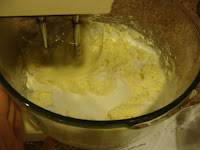What You'll Need
Supplies
Large mixing bowl Measuring cups
2 glass pie plates Measuring spoons
Mixing spoon
Ingredients
2 cans pumpkin pie filling (30 oz) 2 tsp cinnamon
2 cans evaporated milk (24 oz) 1 tsp salt
1 1/2 cups light brown sugar 1/2 tsp ground ginger
4 eggs 1/2 tsp nutmeg
2 pie shells 1/4 tsp ground cloves
Now Let's Make Pumpkin Pie
The great thing about this recipe is that it is super easy. Ridiculously so (this is going to be a really short post, guys. What? Stop cheering!). Start by preheating your oven to 425F; don't forget, cause you definitely have to preheat on this one.
Line your pie plate with the pie crusts. (Again, I harbor a special loathing for doing pie crusts from scratch, so I did Pillsbury). Try to get the crust centered in the plate before you press it down and to the edges. This will make doing the edges a lot easier. Fold the excess pie crust into the shell and press into the sides. This should create a smooth edge right at the rim of the pie plate. Then, go around the pie plate and pinch the crust between your fingers, forming a small peak. Repeat this process all around the pie shell, spacing your peaks evenly about a finger width apart.
Set your crusts aside and break out your large mixing bowl. Now, I like to mix the filling one pie at a time, so that's what the instructions will do here, essentially halving the ingredients listed above. However, you're welcome to try it as is (that ups your chances of unevenly filled pies, though, and who wants that?). Add to your bowl 1 can (15 oz) of pumpkin pie filling and 1 can (12 oz) of evaporated milk (which is never as "evaporated" as I expect). Now measure out 3/4 cup of light brown sugar, making sure it's firmly packed into your measuring cup, and add it to the bowl. Add two eggs, 1 tsp cinnamon, 1/2 tsp salt, 1/4 tsp nutmeg, 1/4 tsp ground ginger, and 1/8 tsp ground cloves. Mix all this up well, making sure that the spices are thoroughly blended and there are no pumpkin filling lumps. Pour the filling into one of your pie shells. Rinse your bowl and repeat for the other shell. (Yes, I know that first picture is less than appetizing).
Bake the pies at 425F for 15 minutes. Go ahead and set a kitchen timer, since this really isn't one you can eyeball. After 15 minutes, reduce the heat to 350F and bake for an additional 40 minutes. These pies should rise as they bake, so don't worry if the center becomes higher than the level of the pie plate; this is normal. Remove pies from oven and set aside to cool. The pies may not seem firm when removed, but the center will set as they cool. Serve warm with whipped cream, or store pies in refrigerator. (But until then, enjoy the before and after shots below)
This particular version is a fairly light, very (delightfully) creamy, not overly sweet pumpkin pie. Also, the subtle spicing balance flavors the pie while still allowing the pumpkiny taste to shine. It's the perfect after Thanksgiving dinner dessert. And also, you have some very easy and yummy pumpkin pies with which to impress your friends!
Line your pie plate with the pie crusts. (Again, I harbor a special loathing for doing pie crusts from scratch, so I did Pillsbury). Try to get the crust centered in the plate before you press it down and to the edges. This will make doing the edges a lot easier. Fold the excess pie crust into the shell and press into the sides. This should create a smooth edge right at the rim of the pie plate. Then, go around the pie plate and pinch the crust between your fingers, forming a small peak. Repeat this process all around the pie shell, spacing your peaks evenly about a finger width apart.
Set your crusts aside and break out your large mixing bowl. Now, I like to mix the filling one pie at a time, so that's what the instructions will do here, essentially halving the ingredients listed above. However, you're welcome to try it as is (that ups your chances of unevenly filled pies, though, and who wants that?). Add to your bowl 1 can (15 oz) of pumpkin pie filling and 1 can (12 oz) of evaporated milk (which is never as "evaporated" as I expect). Now measure out 3/4 cup of light brown sugar, making sure it's firmly packed into your measuring cup, and add it to the bowl. Add two eggs, 1 tsp cinnamon, 1/2 tsp salt, 1/4 tsp nutmeg, 1/4 tsp ground ginger, and 1/8 tsp ground cloves. Mix all this up well, making sure that the spices are thoroughly blended and there are no pumpkin filling lumps. Pour the filling into one of your pie shells. Rinse your bowl and repeat for the other shell. (Yes, I know that first picture is less than appetizing).
Bake the pies at 425F for 15 minutes. Go ahead and set a kitchen timer, since this really isn't one you can eyeball. After 15 minutes, reduce the heat to 350F and bake for an additional 40 minutes. These pies should rise as they bake, so don't worry if the center becomes higher than the level of the pie plate; this is normal. Remove pies from oven and set aside to cool. The pies may not seem firm when removed, but the center will set as they cool. Serve warm with whipped cream, or store pies in refrigerator. (But until then, enjoy the before and after shots below)
 |
| "I want my pumpkin pie!" |
Follow @TheBookPantry























































